
A steam locomotive is a locomotive that provides the force to move itself and other vehicles by means of the expansion of steam. It is fuelled by burning combustible material to heat water in the locomotive's boiler to the point where it becomes gaseous and its volume increases 1,700 times. Functionally, it is a steam engine on wheels.

A tank locomotive is a steam locomotive which carries its water in one or more on-board water tanks, instead of a more traditional tender. Most tank engines also have bunkers to hold fuel; in a tender-tank locomotive a tender holds some or all of the fuel, and may hold some water also.

The Great Western Railway 3700 Class, or City Class, locomotives were a series of twenty 4-4-0 steam locomotives, designed for hauling express passenger trains.

George Jackson Churchward was an English railway engineer, and was chief mechanical engineer of the Great Western Railway (GWR) in the United Kingdom from 1902 to 1922.
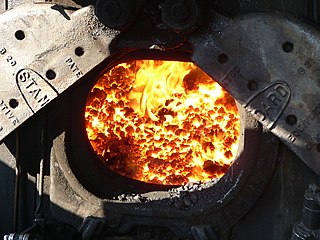
In a steam engine, the firebox is the area where the fuel is burned, producing heat to boil the water in the boiler. Most are somewhat box-shaped, hence the name. The hot gases generated in the firebox are pulled through a rack of tubes running through the boiler.

The GWR 4100 Class was a class of steam locomotives in the Great Western Railway (GWR) of the United Kingdom.

The Great Western Railway 3252 or Duke Class were 4-4-0 steam locomotives with outside frames and parallel domed boilers. They were built in five batches between 1895 and 1899 for express passenger train work in Devon and Cornwall. William Dean was their designer, possibly with the collaboration of his assistant, George Jackson Churchward. Four prototype 4-4-0s, of the Armstrong Class, had already been built in 1894.
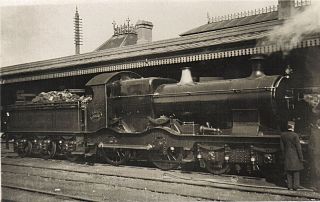
The Bulldog and Bird classes were double-framed inside cylinder 4-4-0 steam locomotives used for passenger services on the Great Western Railway. The Bird Class were a development of the Bulldogs with strengthened outside frames, of which a total of fifteen were built. A total of 121 Bulldogs were built new, with a further twenty rebuilt from Duke Class locomotives. Thirty Bulldogs were later rebuilt as Earl Class locomotives and renumbered 3265, 3200-3228.

The Belpaire firebox is a type of firebox used on steam locomotives. It was invented by Alfred Belpaire of Belgium in 1864. Today it generally refers to the shape of the outer shell of the firebox which is approximately flat at the top and square in cross-section, indicated by the longitudinal ridges on the top sides. However, it is the similar square cross-section inner firebox which provides the main advantages of this design i.e. it has a greater surface area at the top of the firebox where the heat is greatest, improving heat transfer and steam production, compared with a round-top shape.
Boilers for generating steam or hot water have been designed in countless shapes, sizes and configurations. An extensive terminology has evolved to describe their common features. This glossary provides definitions for these terms.

A haycock boiler is an early form of steam locomotive boiler with a prominently raised firebox of "Gothic arch", "haystack", or "coppernob" shape. The term haystack is most commonly used, but is avoided here as it is confusingly used for three quite different forms of boiler. This particularly large outer firebox served as the steam dome and was often highly decorated with polished brass. These were popular for early railway locomotives, from 1840 to the 1850s.

The Great Western Railway's 1813 Class was a series of 40 0-6-0T built at Swindon Works in two lots of 20 engines each. No. 1813 was sold to the Pembroke & Tenby Railway in May 1883 becoming No.7 Holmwood, retaining this name after being absorbed by the GWR. Nearly all of these engines spent their lives on the GWR's Southern Division.

The South African Railways Class 16E 4-6-2 of 1935 is a class of passenger steam locomotive.
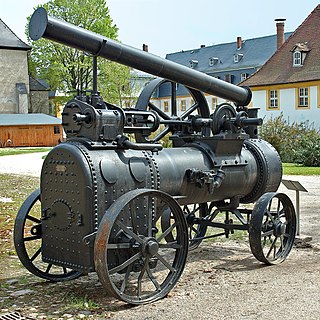
A round-topped boiler is a type of boiler used for some designs of steam locomotive and portable engine. It was an early form of locomotive boiler, although continuing to be used for new locomotives through to the end of steam locomotive manufacture in the 1960s.
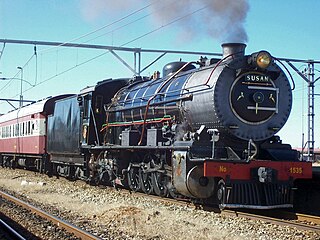
The South African Railways Class 12A 4-8-2 of 1919 was a steam locomotive.

The South African Railways Class 10C 4-6-2 of 1910 was a steam locomotive from the pre-Union era in Transvaal.
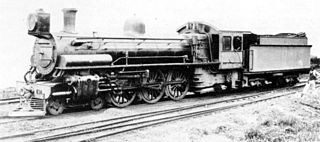
The South African Railways Class 10B 4-6-2 of 1910 was a steam locomotive from the pre-Union era in Transvaal.
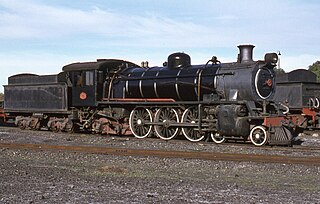
The South African Railways Class 5 4-6-2 of 1912 was a steam locomotive.

The South African Railways Class 3 4-8-2 of 1909 was a steam locomotive from the pre-Union era in the Colony of Natal.
The L&YR 2-10-0 was a prospective design for a class of 2-10-0 steam locomotives on the Lancashire and Yorkshire Railway. Initial designs were made by George Hughes between 1913 and 1914, but none of the class were built. If they had been, these would have been the UK's first 10-coupled locomotives in regular service.





















